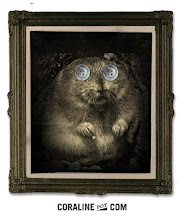Regardless, it's question and answer time, boys and girls. A little quid pro quo - my teacher gives me something and I give her something back.
Question 1: At the bottom of p. 21 (Ch. 3, if your page numbers differ), Lecter lectures Starling, saying, "You can't reduce me to a set of influences. You've given up good and evil for behaviorism....Can you stand to say I'm evil? Am I evil, Officer Starling?"
Why does the answer to this question matter?
What are the implications of choosing "influences" over "evil"?
When Dr. Lecter brings up the concept of evil to Clarice for the first time, he is forcing her to complicate her world view. He sees her as a simple woman with simple thoughts and he wishes to test her – to challenge her. In reply to Lecter’s question of whether or not she believes him to be evil, Clarice says, “I think you’ve been destructive. For me it’s the same thing” (19). He then reminds her that storms, fire, and hail are all destructive, so by her argument, these natural acts of weather must be evil. He further points out an example of a church collapse that killed 65 elderly woman and asks if this was evil, since clearly it was destructive. Lecter asks Clarice, “Was that evil? If so, who did it? If He’s up there, He just loves it, Officer Starling. Typhoid and swans – it all comes from the same place” (19).
Lecter is Clarice to acknowledge that God (if he exists) has created the things she considers evil just as he has created the things she considers pure. Further, he draws attention to the fact that these things are not so different after all – they are a part of the world’s strange duality; the beautiful and the ugly, the good and the evil, the gentle and the violent all have the same origin. The theory that evil and good are somehow completely separate does not work for Lecter, nor should it since they can only be defined as binary opposites to one another. He is especially put off by the fact that Clarice has “everybody in moral dignity panties – nothing is ever anybody’s fault” (19).
This idea of “moral incontinence”, of something happening to Lecter to make him turn out the way he did, implies that behavior can be explained away by the experiences and influences of a person’s life. This would mean nobody was responsible at all for their actions – there is no thinking involved, no need to choose, and that what a person does is not their own, but some predestined outcome decided by their past. Lecter would find this idea insulting as he takes great pride in his intelligence and his skill. He feels that he is doing the world a great service by consciously choosing to rid it of rude people as, after all, “discourtesy is unspeakably ugly to [him]” (22).
The larger problem for Clarice however, is that she is faced with the reality the world is not as clean cut as she has chosen to believe. Things are not black and white or even shades of gray, but have the potential for real color. Up until now, Clarice was able to believe that things are either good or bad, but with Lecter, she has no choice but to reconsider other options.
Whether or not she would like to admit it, Lecter’s message has gotten into Clarice’s subconscious at least a little, because later when she is discussing moths at the Smithsonian, she says “they’re destructive” (96). Though the moth is in some way associated with “evil” since it is being linked directly to Buffalo Bill, it does not seem Clarice thinks of a moth itself as evil although she said initially destructive was the same thing.

No comments:
Post a Comment